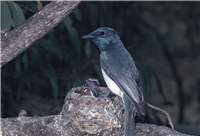Family
Dicruridae
Genus
Myiagra
Species
rubecula
Threats/Control Methods - Regional
Regional populations of Leaden Flycatchers are dependant on the surrounding woodland, which are considered an Endangered Ecological Community. Land clearing for agriculture and expanding urban developments, grazing and weed dispersal threaten this breeding area through habitat simplification.
Threats/Control Methods - Local
Domestic Cats (Felis catus) put birds moving into the suburbs at an increased risk of predation.
Local/Urban Actions
Canberra residents can encourage the birds into the local region by participating in tree planting or bush regeneration activities with local Landcare groups or with Greening Australia. Cat owners can encourage Leaden Flycatchers safely into the suburbs by providing a stimulating indoor environment for their pets or by installing a cat enclosure.
Common Names
Leaden Flycatcher, Blue Flycatcher, Frog Bird
Distinguishing Features
This small 15-16cm bird is most recognisable by its short crest on the top of its head. It has a dark eye, bill and legs. Male birds are lead-grey with a blue sheen, except for their white underparts. Female birds have a pale, rusty coloured throat and breast, with remaining plumage a dull blue-grey to brown colour. Young birds are dull with some rusty colourings along their wings.
Survey Techniques
Call and visual identification.
Species Call
A clear whistling 'whit-ee-eight' , 'too-wheit' or a harsh buzzing.
Similar Species
The Satin Flycatcher (Myiagra cyanoleuca) is almost idenitcal, however male birds are more black and glossy, and females have a darker rusty-coloured patch.
Distribution
This species is found across the north of WA, NT and QLD, and down to Adelaide and TAS in lower abundance. Northern species migrate to and from Papua New Guinea.
Country of Origin
Australia
Conservation (Pet/Pest) Status - Regional
Numbers have fluctuated widely over the past 25 years, seeming stable overall (COG).
Conservation (Pet/Pest) Status - National
Secure, not listed under the EPBC Act 1999. The Leaden Flycatcher is common in northern Australia, uncommon in the southeast. The population of the Torres Straight (Myiagra rubecula papuana) is Near Threatened, due to the confined area of the population.
LSCCES Population
Six sightings were made at the ANBG during the survey period, however they are known to breed on the ANU campus and in suburban Turner and O'Connor.
Associated vegetation community
The Leaden Flycatcher inhabits eucalypt forest, woodland, mangroves and the edge of rainforest areas.
Limiting Resources
This species is found in a very diverse range of habitats, however it is only found in areas with understory vegetation of logs and shrubs. It depends on the surounding woodlands of the Canberra region for breeding and will only be seen in suburbs with large nearby nature reserves.
Breeding
The breeding season runs over the summer months from late November to early March in the Canberra region. The breeding pair shares all the nesting responsibilities, beginning nest building on a tree limb 6-20 metres high. The nest is constructed of thin pieces of bark, joined with spider web and extremely well camouflaged into the tree branch with moss, matching the colour and texture of the branch itself. The female lays 2-3 white eggs with a band of grey and black speckles. Parents then incubate the eggs for about 2 weeks and then care for the young for another 15days.
Behaviour
The Leaden Flycatcher is a summer migrant to the Canberra region. This active bird is usually seen alone or in pairs, often buzzing around tree foliage for insects, snatching them in flight. It seems to love attention, frequently calling and flicking its tail while perched, especially in spring.
Functional Group
Food Species
This species eats a range of available insects from tree foliage.
Predators
Both domestic and feral Cats (Felis Catus) can attack and kill this species.
Interesting Fact
The nest of the Leaden Flycatcher is extremely well camouflaged, skilfully built with a tree's bark and moss to look like a bump or knothole on the tree branch.
References - (reader suitability of references, P=Primary teachers, S=Secondary students, T=Tertiary students and researchers)
Books:Morcombe, M. 2000. Field Guide to Australian Birds. Steve Parish Publishing. Archerfield. Australia P, S, T
Pizzey, G. 2000. The Graham Pizzey & Frank Knight Field Guide to the Birds of Australia. Angus & Robertson, Sydney. P, S, T
Veerman, P. 2003. Canberra Birds: A report on the first 21 years of the garden bird survey. Philip Veerman and Canberra Ornithologists Group. Canberra. S, T
Internet: Birds in Backyards. 2006. [online]. Available at:http://www.birdsinbackyards.net P, S, T
Canberra Ornithological Group (COG). 2004. Birds of Canberra Gardens. COG and the ACT Department of Urban Services. [online]. Available at:http://garden.canberrabirds.org.au/ P, S, T
Online Publications:ACT Government. 2004. Woodlands for Wildlife: ACT Lowland Woodland Conservation Strategy. Action Plan No. 27. Environment ACT, Canberra. [online]. Available at: http://www.environment.act.gov.au/nativeplantsandanimals/threatecspec/woodlandsstrategy S, T
Garnett, S. and Crowley, M. 2000. The Action Plan for Australian Birds 2000. Department of Environment and Water Resources. [online]. Available at: http://www.deh.gov.au/biodiversity/threatened/publications/action/birds2000/index.html S, T
Nix, H. and Cunningham, R. 2006. Birds of the Lower Sullivans Creek Catchment, Canberra ACT. Prepared for the Life in the Suburbs project using data from the Lower Sullivans Creek Catchment Ecological Survey (LSCCES). Australian National University. Canberra. [online]. Available at: http://www.lifeinthesuburbs.com.au/category.php?id=65 S, T

 Top
Top Top
Top